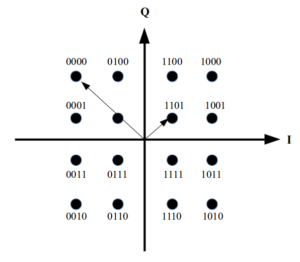Quadrature Amplitude Modulation (QAM) is the combination and modulation of two signals which have a 90º phase shift from one another. It is the 90º phase shift which causes the two signals to be in quadrature. The first signal is called the in-phase signal and the other is refered to as the quadrature signal.
A straight amplitude modulated signaloccupies twice the bandwidth of the modulating signal. QAM is more advanteageous than straight amplitude modulation because it places two independent double sideband suppressed carrier signals in the same spectrum as one ordinary double sideband supressed carrier signal. This uses only half the bandwidth as a normal double sideband surpressed carrier signal; therefore, QAM used in digital transmission can carry carry higher data rates than ordinary amplitude modulated schemes and phase modulated schemes. [1]
References
IEEE Article: BER analysis of rectangular QAM/FSO system
IEEE Article: Selective relay decode-and-forward QAM/FSO systems

